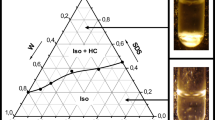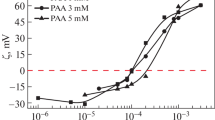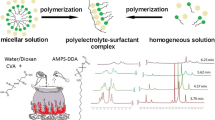Abstract:
We report on the phase behavior and scattering properties of colloidal complexes made from block copolymers and surfactants. The copolymer is poly(sodium acrylate)-b-poly(acrylamide), hereafter abbreviated as PANa-PAM, with molecular weight 5000 g/mol for the first block and 30000 g/mol for the second. In aqueous solutions and neutral pH, poly(sodium acrylate) is a weak polyelectrolyte, whereas poly(acrylamide) is neutral and in good-solvent conditions. The surfactant is dodecyltrimethylammonium bromide (DTAB) and is of opposite charge with respect to the polyelectrolyte block. Combining dynamical light scattering and small-angle neutron scattering, we show that in aqueous solutions PANa-PAM diblocks and DTAB associate into colloidal complexes. For surfactant-to-polymer charge ratios Z lower than a threshold (Z C ∼ 0.3), the complexes are single surfactant micelles decorated by few copolymers. Above the threshold, the colloidal complexes reveal an original core-shell microstructure. We have found that the core of typical radius 100-200 Å is constituted from densely packed surfactant micelles connected by the polyelectrolyte blocks. The outer part of the colloidal complex is a corona and is made from the neutral poly(acrylamide) chains. Typical hydrodynamic sizes for the whole aggregate are around 1000 Å. The aggregation numbers expressed in terms of numbers of micelles and copolymers per complex are determined and found to be comprised between 100-400, depending on the charge ratio Z and on the total concentration. We have also shown that the sizes of the complexes depend on the exact procedure of the sample preparation. We propose that the driving mechanism for the complex formation is similar to that involved in the phase separation of homopolyelectrolyte/surfactant systems. With copolymers, the presence of the neutral blocks prevents the macroscopic phase separation from occurring.
Similar content being viewed by others
Author information
Authors and Affiliations
Additional information
Received 24 July 2002
RID="a"
ID="a"e-mail: jeanfrancois.berret@us.rhodia.com
Rights and permissions
About this article
Cite this article
Berret, JF., Cristobal, G., Hervé, P. et al. Structure of colloidal complexes obtained from neutral/poly- electrolyte copolymers and oppositely charged surfactants. Eur. Phys. J. E 9, 301–311 (2002). https://doi.org/10.1140/epje/i2002-10063-7
Issue Date:
DOI: https://doi.org/10.1140/epje/i2002-10063-7




